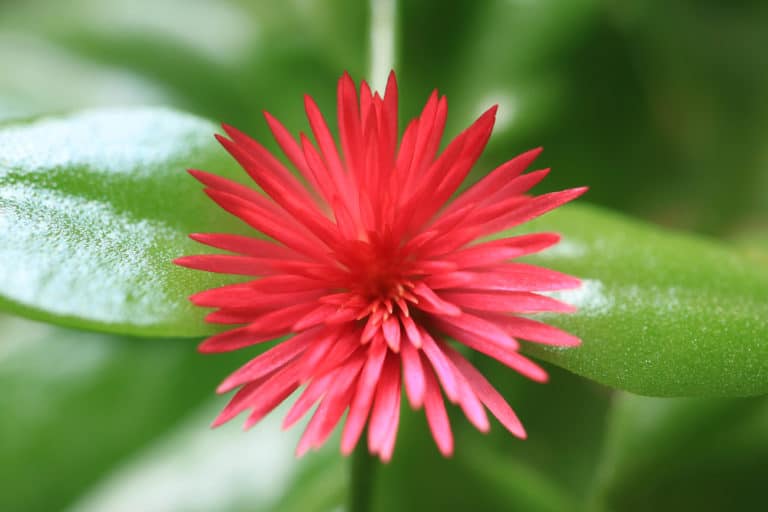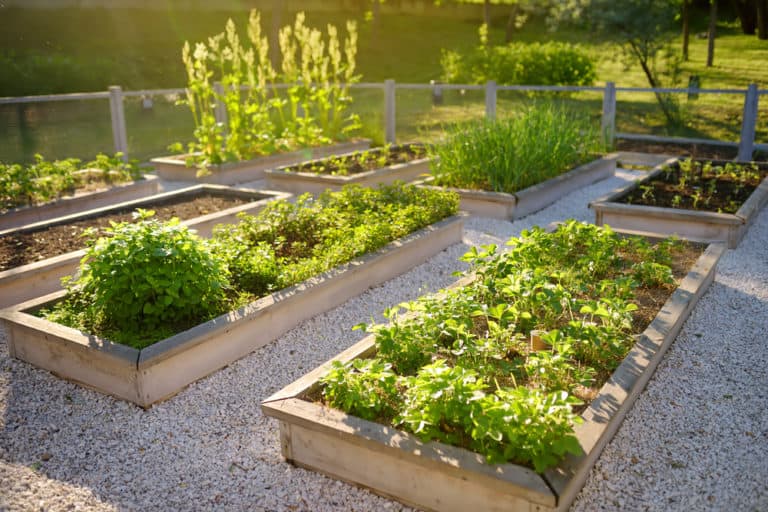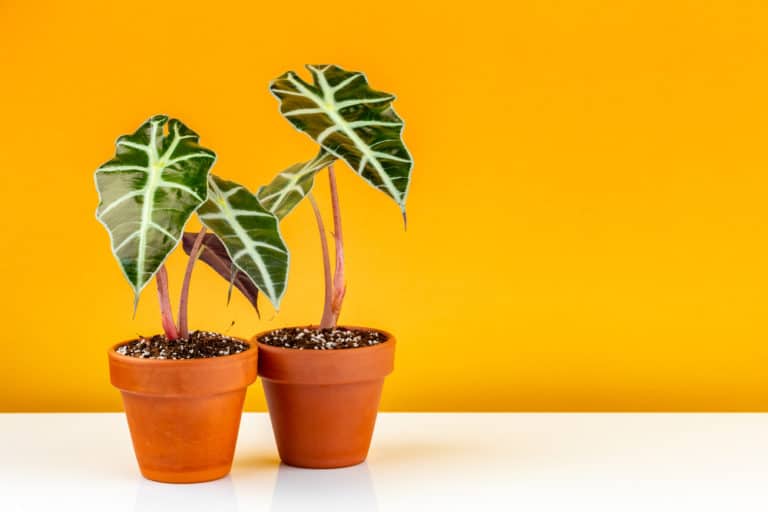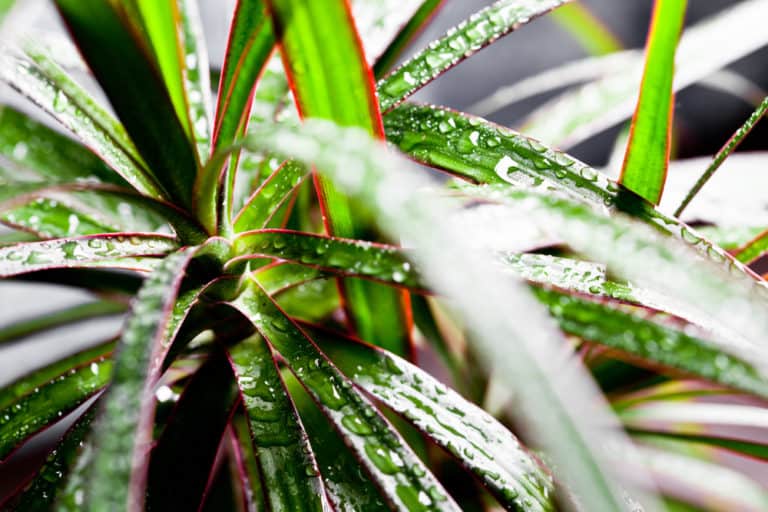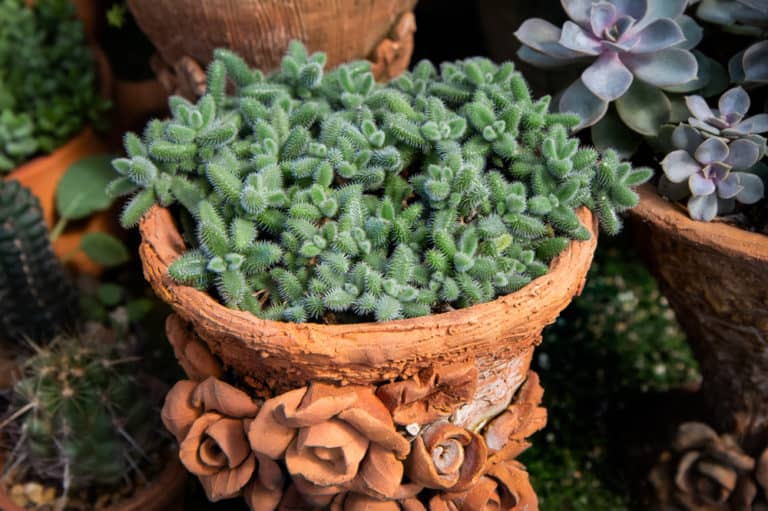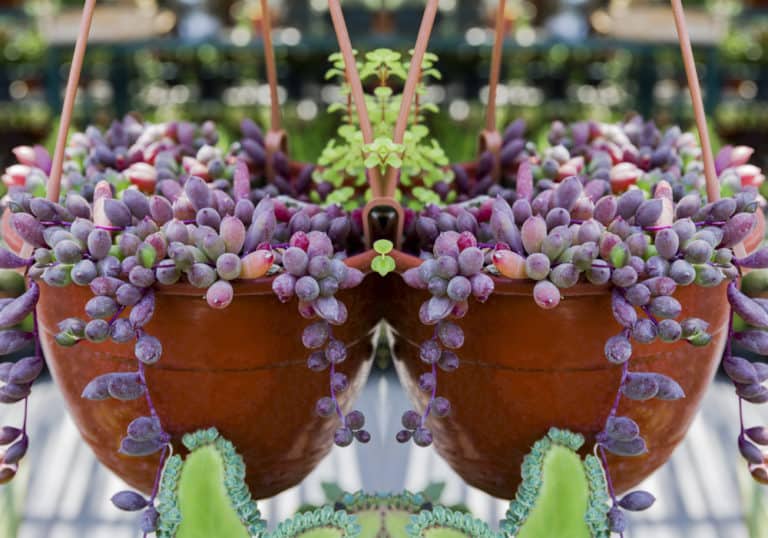Dieffenbachia ‘Dumb Cane Camille’ Care Guide (2024)

Dieffenbachia Camille is a particularly attractive Dieffenbachia cultivar that is also really easy to grow, even for beginner indoor gardeners.
A Dumb Cane Camille plant will adapt to a wide range of growing conditions, so you are likely to have a suitable spot in your home or office for it.
| Scientific Name | Dieffenbachia seguine ‘Camille’ |
| Common Name | Dumb Cane Camille, Dieffenbachia Camille, Leopard Lily Camille |
| Light | Bright indirect sunlight |
| Watering | Water if the top inch of soil is dry |
| Temperature | 61 to 80ºF (16 to 27ºC) |
| Hardiness Zone | 10 to 12 |
| Humidity | 60% |
| Soil Type | Rich, quick-draining, loamy |
| Soil pH | 6.1 to 6.5 (mildly acidic) |
| Fertilizing | A balanced feed once a month in spring and summer |
| Repotting | Every 1 to 2 years |
| Pruning | At any time of the year. |
| Propagation | Root in water or soil |
| Toxicity | Toxic to humans and pets |
| Mature Size | 3 to 5 feet as a houseplant |
| Bloom Time | Rarely blooms indoors |
What’s Unique About Dieffenbachia Camille?
The Dieffenbachia Camille plant is a recent cultivar in the Dieffenbachia family. These plants are native to the tropical rainforests of the Caribbean and South America, and have long been grown as houseplants.
It’s notable for its large leaves, featuring a creamy white center with bright green margins.
Dieffenbachia Camille plants are ideally suited to indoor cultivation, as they will stay at a reasonable size of 3 feet.
As well, growing Dieffenbachia Camille is easy, as it will happily adapt to a fairly wide range of growing conditions. Just make sure that you can give it the humidity it craves!
Dieffenbachia Camille Care
In the tropical rainforests where it originates, Dieffenbachia Camille thrives in a hot, steamy environment on the forest floor, beneath the tree canopy.
However, good Dieffenbachia Camille plant care doesn’t involve turning your home into a dense, humid jungle.
You will find that Dumb Cane Camille care is pretty reasonable, but be prepared to do a little extra work to keep the humidity level high.
Light
Dieffenbachia Camille light requirements are pretty standard for a plant which evolved on the forest floor in a tropical rainforest.
The equatorial sun is blazing bright overhead, but once it’s been filtered through the tree canopy far overhead, the plants growing at ground level get a dappled shade.
Dumb Cane Camille light needs are for bright, indirect light, or about 10,000 to 20,000 lux.
As long as you can provide up to 8 hours a day of indirect light, such as in a north or east window, your Dieffenbachia Camille will be fine.
Just keep it out of the full sun to avoid burning its beautiful leaves.
Watering
As you might imagine, a rainforest native like Dieffenbachia Camille is used to continual moisture in the soil.
However, at the same time, it’s also used to soil that drains away excess water, so it will not tolerate sitting in soaking wet soil.
Your Dieffenbachia Camille watering routine should aim for soil that is consistently moist, but never sopping wet.
Water Dumb Cane Camille whenever the first inch or so of the soil has dried out. Just stick your finger in and check.
Then, slowly pour tepid water over the entire surface until water starts trickling out the bottom.
Dieffenbachia Camille’s watering needs will be greater in spring and summer when it is actively growing.
Temperature
Dieffenbachia Camille likes it on the warm side, which is hardly a surprise for a plant which grew in the tropics.
It will grow from 61 to 80ºF (16 to 27ºC). Most modern homes will fall right around the middle of that Dieffenbachia Camille temperature range.
Of course, the higher the temperature for Dumb Cane Camille, the more luxuriant its growth will be. An easy way to give it a heat boost is to move it outdoors in the steamy summer months.
Be aware, however, that Dieffenbachia Camille has limited temperature tolerance below 60ºF (15ºC). If it is in a drafty spot or too close to a cold window, it will lose its lower leaves.
As well, Dieffenbachia Camille has no frost hardiness at all, and it will be killed by freezing temperatures.
Humidity
Meeting Dieffenbachia Camille humidity requirements is probably the single most important factor in keeping this plant happy in your home.
The ideal humidity for Dumb Cane Camille is between 60 to 80%. You really don’t want to let the humidity level around your Dieffenbachia Camille drop much further than 60%.
That does not mean you have to turn your whole house into a steam bath.
Your first option is to set your Dieffenbachia Camille pot atop a pebbled tray filled with water, which will evaporate into the air around your plant.
However, probably the best way to increase the humidity for your Dieffenbachia Camille and other tropical plants is to group them together.
Place a humidifier in their midst to create the perfect microclimate for them all.
Soil
Your Dieffenbachia Camille soil should be similar to what they are used to in the rainforest: a spongy, loose mix high in organic matter.
The potting soil must not only retain some moisture, but also drain away any excess, as the roots must be able to breathe.
The best pH level for Dumb Cane Camille is 6.1 to 6.5, or mildly acidic.
Since they have very similar needs, you can use a commercial African Violet soil for Dumb Cane Camille.
However, it will also do very well with a custom soil mix made with two-thirds peat moss and one-third perlite.
Fertilizer
Using fertilizer for Dumb Cane Camille on a regular basis will encourage the growth of big, beautiful leaves.
Use a standard liquid houseplant fertilizer with a balanced fertilizer ratio of 20-20-20. Dilute it to half the recommended strength.
How often you apply Dieffenbachia Camille fertilizer will depend to a great extent on how much light it gets.
A plant in a brighter spot will need more frequent fertilizing than one growing in a shadier location. Usually, however, once a month in the growing season will be enough.
Shortly after watering, pour the liquid fertilizer solution evenly over the soil surface.
Potting & Repotting
Dieffenbachia Camille repotting may have to be done as frequently as once a year, and certainly not beyond every two years.
Watch out for signs of it becoming rootbound. When water runs right through the pot, or roots are poking out of the drainage holes or coming up to the soil surface, it’s time to repot.
The best time for repotting Dumb Cane Camille is in early spring, just as it’s starting its growing season.
Only go up one pot size, as you want to maintain a good ratio between the root ball and soil.
Always replace the potting soil to prevent the buildup of disease and salts in the soil.
Pruning
Dieffenbachia Camille pruning can be done at any time of the year.
The most essential reason for cutting Dumb Cane Camille is to remove dead or damaged leaves.
Over time, the leaves at the bottom, which are the oldest, will wither and die, and you need to keep your Dieffenbachia Camille looking its best.
Aside from that, you can trim your Dieffenbachia Camille if you want to limit its height or encourage bushier growth.
Simply cut stems just above a node, which will soon send out new lateral growth.
If your Dieffenbachia Camille is getting leggy and unkempt, you can cut the canes back to about 6 inches, and let them put out fresh, new growth.
Always use sharp, sterilized scissors or knives, and avoid getting the sap on your skin.
Propagation
The two easiest methods of Dieffenbachia Camille propagation are root division and stem cuttings.
To propagate Dumb Cane Camille by root division, wait until you are repotting your plant.
Once you’ve pulled the root ball out and cleared the soil off of it, you should be able to see offsets growing around the edge of the mother plant.
Gently tug them off, cutting if necessary, and then plant out each new baby Dieffenbachia Camille in its own pot.
Stem cuttings will quickly root in soil. Cut short lengths of stems, ensuring that each has several nodes.
Lay the pieces on their side in soil, and cover them with a cloche to conserve heat and humidity.
Within a few weeks, new roots and stems should be showing, and you can plant them in pots.
Common Problems of Dieffenbachia Camille
Dieffenbachia Camille problems can usually be prevented with regular maintenance and proper watering techniques.
However, if the leaves are not looking their best, you should quickly determine the cause and find the appropriate solution.
Most problems with Dumb Cane Camille can be solved, returning your tropical plant to healthy growth.
Pests
It is a sad fact of houseplant life that bugs love them, and the likely Dieffenbachia Camille pests are the regular offenders.
The best way to protect your Dumb Cane Camille from insect infestations is to wipe down the leaves every month with a mild insecticdal solution such as insecticidal soap or neem oil.
Spider mites are only likely to turn up if humidity levels are too low. If you see yellow spots, or sticky webs, spray the leaves thoroughly in the shower or sink.
Mealybugs look like white puffs on the underside of the leaves. Wipe them off with an alcohol-soaked cotton ball.
Aphids are soft-bodied pale green flies. Get rid of them with a handheld vacuum.
Scale insects resemble small brown bumps, usually on the stems, Scrape them off.
Diseases
Most Dieffenbachia Camille diseases can only take hold if they have the perfect growing conditions of a wet and warm environment.
Root rot happens when the soil is too wet. If leaves are yellowing, and the stems are mushy, pull out the root ball and examine it.
If roots are turning black with a bad smell, cut off all infected parts and replant your Dumb Cane Camille in fresh soil.
Erwinia blight will first appear on the lower leaves, causing mushy spots with a fishy smell.
Move your Dieffenbachia Camille away from all other plants, and remove all affected leaves immediately, throwing them in the garbage.
Repot it in a new pot with fresh soil, and monitor it carefully. If the spots return, you will have to get rid of the plant.
Growing Problems
Some Dieffenbachia Camille growing problems can be resolved just by improving the growing conditions of your sick plant. It may take a little detective work to determine the exact cause, though!
If your Dieffenbachia Camille leaves are turning yellow, that could indicate overwatering, underwatering, or a nutrient deficiency. Once you’ve checked the soil moisture, you should be able to figure out what you need to do.
Drooping leaves may mean too much or too little sun, or too cold a growing location.
Faded, thin leaves usually mean that your Dieffenbachia Camille is getting too much sun.
Toxicity of Dieffenbachia Camille
Dumb Cane Camille is toxic to humans and pets.
The toxicity is because of the calcium oxalate crystals, or raphides, that can be found in all parts of the plant. When they come in contact with skin or internal tissues, they can cause intense pain.
The raphides also release enzymes that can increase the severity of symptoms.
For Humans
Dieffenbachia Camille is toxic to humans, so you should avoid any exposure to the sap, and certainly never eat any portion of it.
Children, however, do not always do what they are told, and may try nibbling on a leaf. They won’t do more than that, because they will immediately experience pain.
Rinse out their mouth with water, and clean off their skin. If it’s just localized pain in their lips, give them a soothing treat like ice cream.
However, if they have a swollen tongue, or constricted airways, you should take them to the emergency room at once.
If some of the sap gets on your skin, rinse it for 15 minutes.
For Pets
Dieffenbachia Camille is toxic to all household pets, including cats, dogs, and rabbits.
If your pet eats some of the foliage, even if it’s a small bite, they can have a severe reaction.
This can include vomiting, drooling, or wheezing. They may have a swollen mouth and be unable to eat or drink.
It’s best to take your pet to the veterinarian after ingesting Dieffenbachia Camille foliage, as they could have stomach or esophageal damage from the raphides.
At the very least they will need something to relieve the pain.
Keep your Dieffenbachia Camille out of reach of the small members of your household. Since it can be kept to 3 feet tall, you should be able to find a high shelf to keep it at a safe distance.
Dieffenbachia Camille Appearance
The fresh, bright Dieffenbachia Camille appearance makes it a good choice for either traditional or modern settings.
The large cream and green leaves grow in profusion, quickly creating a full, bushy plant.
It’s unlikely to flower indoors, but those blooms will not be missed when you have the beautiful foliage to enjoy.
Foliage
The foliage of Dieffenbachia Camille is among the loveliest available.
A Dieffenbachia Camille leaf has a wide, oval shape and grows up to 16 inches long.
Each leaf has a broad swathe of creamy white across the center of the leaf, framed by a bright green margin. The center rib is pale green.
The leaves have a thick, leathery texture, and a smooth surface.
Keep them looking their best by wiping them down once a month with a damp cloth.
If they develop any browned edges, simply trim them off carefully with sharp scissors, leaving the rest of the leaf intact.
Flowering
You will not often see a Dumb Cane Camille flower on an indoors potted plant. They simply don’t have the size to support blooming.
Dieffenbachia Camille flowering usually only occurs on plants grown outdoors in the ground in tropical climates.
When they do bloom, you will see an insignificant flower consisting of a green spathe and cream spadix. They are reported to have an earthy but not unpleasant smell.
You may decide to cut off the flowers as they emerge, to let your Dieffenbachia Camille concentrate its energies on its foliage.
As well, a Dieffenbachia Camille may die after it has completed its flowering cycle, so cutting out the flowers will keep it going.
Size and Growth
When grown indoors, the mature size of Dieffenbachia Camille is usually about 3 feet tall and 3 feet across, although as much as 5 feet is possible.
Outdoors in a tropical zone, they may reach 10 feet in height.
It has a moderate to fast growth rate, taking 2 to 5 years to reach its full size.
Dieffenbachia Camille naturally forms into a full, bushy clump, with lots of leaves to fill it out. They arch out gracefully on their upright stems.
As the Dieffenbachia Camille matures, the lower leaves start to fall off, revealing the stem as it starts to take on more of a tree shape.
Dieffenbachia Camille Fragrance
The only time you would detect any Dieffenbachia Camille fragrance is in the unlikely event that it blooms for you indoors.
While the flowers do have a scent, it’s not a particularly fragrant one. It’s usually described as “earthy”. Especially if you’re growing your Dieffenbachia Camille in a small space, you may well choose to cut them out for that reason.
The foliage has no fragrance, making it ideal for growing around individuals with a sensitivity to scents.
Of course, since Dieffenbachia Camille is a good air purifier, it can actually improve your indoor environment by filtering out dangerous chemicals.
Suggested Uses for Dieffenbachia Camille
Indoors or outside, growing a Dieffenbachia Camille is a great way to add some tropical vibes to your home.
It’s small enough to tuck into the corner of your bedroom to clean the air as you sleep, or put in a bathroom so it can revel in the high humidity.
Move it outdoors to a shady balcony or patio for the hot and humid summer months. Be careful, however, if you plant it outdoors in a tropical zone, as they can spread and become invasive.
Place your Dieffenbachia Camille separately as an accent piece, or include it in a larger tropical garden where its bright, fresh-looking leaves will stand out.
FAQ
What is Dieffenbachia Camille?
Dieffenbachia Camille is a cultivar in the Dieffenbachia family, which is native to the tropical rainforests of the Caribbean and South America. It is a popular houseplant.
How to identify Dieffenbachia Camille?
Dieffenbachia Camille has large, oval leaves with a creamy white center and a narrow margin of bright green. It grows into a compact, bushy plant.
How to care for Dieffenbachia Camille?
Dieffenbachia Camille should be grown in a moderately bright spot out of full sun, in consistently moist soil, in warm temperatures and humidity as high as possible.
How to grow Dieffenbachia Camille indoors?
Dieffenbachia Camille can be grown indoors as a potted plant, in a warm, humid environment with bright, indirect light and regular watering and fertilizing.
How to grow Dieffenbachia Camille outdoors?
Dieffenbachia Camille can be grown outdoors year-round in tropical zones, but it can become an invasive weed, so it’s best to grow it as a container plant.
How fast does Dieffenbachia Camille grow?
Dieffenbachia Camille has a moderate to fast growth rate, taking 2 to 5 years to reach its full size of 3 to 5 feet indoors.
How tall does Dieffenbachia Camille grow?
Dieffenbachia Camille usually grows to a height and width of 3 feet when grown indoors, although it will sometimes get as tall as 5 feet.
How to make Dieffenbachia Camille grow faster?
Dieffenbachia Camille will grow its fastest when given ideal growing conditions, especially warm temperatures and humidity as high as 80%, as well as regular watering and fertilizing.
How to stake Dieffenbachia Camille?
Dieffenbachia Camille may need to be staked as it gets taller, since the weight of the leaves may be too much for its stem. Using a simple bamboo pole should suffice.
How to pot Dieffenbachia Camille?
Dieffenbachia Camille should be planted in porous soil with lots of organic material, in a pot with adequate drainage holes. Repotting should be done in early spring.
How to revive Dieffenbachia Camille?
A leggy Dieffenbachia Camille can be cut back to within a few inches of the soil level, and the stems will put out fresh new leaves.
Why is my Dieffenbachia Camille dying?
Your Dieffenbachia Camille may have a fungal or bacterial disease affecting either the leaves or the roots. Cut off all infected parts and replant it in fresh soil.
Why is my Dieffenbachia Camille drooping?
Drooping leaves may indicate that your Dieffenbachia Camille may be in too cold a location, or be getting too much or too little sun to thrive.
How cold can Dieffenbachia Camille tolerate?
Dieffenbachia Camille will suffer damage at temperatures below 60ºF (15ºC), and freezing temperatures will kill it. Keep it out of drafts and away from cold windows.
How to get rid of pests on Dieffenbachia Camille?
Dieffenbachia Camille pests can be discouraged by wiping down both sides of the leaves once a month with an insecticidal soap or neem oil solution.
Is Dieffenbachia Camille toxic to cats?
Yes, Dieffenbachia Camille is toxic to cats. Even a small bite of a leaf can cause intense pain, vomiting, wheezing, or drooling, and requires veterinary care.
Is Dieffenbachia Camille toxic to dogs?
Yes, Dieffenbachia Camille is toxic to dogs. If your dog has a swollen tongue, or is wheezing or vomiting, take it to the veterinarian immediately.
Is Dieffenbachia Camille toxic to children?
Yes, Dieffenbachia Camille is toxic to children. If your child has a swollen tongue or difficulty breathing, take them to the emergency room as soon as possible.
Is Dieffenbachia Camille toxic to humans?
Yes, Dieffenbachia Camille is toxic to humans. The sap can cause a painful rash, so if it gets on your skin rinse it under running water for 15 minutes.
Does Dieffenbachia Camille have a scent?
The rare Dieffenbachia Camille flowers have an earthy smell, but the foliage has no fragrance, making it suitable for use around people with allergies to scents.

